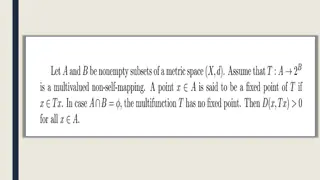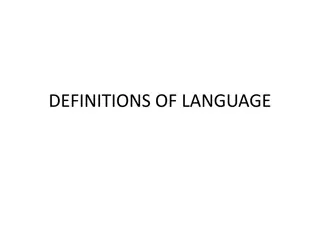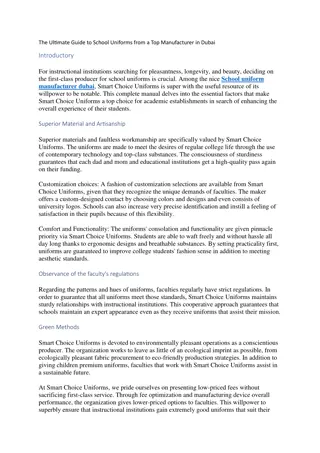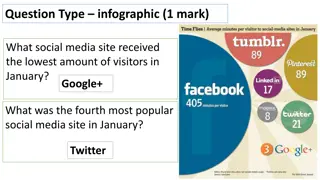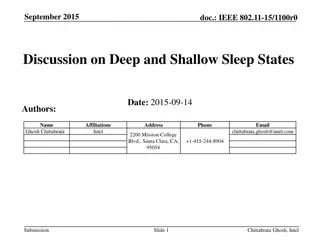Understanding Different Kinds of Years and Their Definitions
Explore the concept of different kinds of years including the solar year, sidereal year, and tropical year. Understand the significance of each type of year in relation to the sun's revolution and the occurrence of seasons. Discover how the tropical year is affected by the phenomenon of precession, leading to retrograde motion in the celestial sphere.
Download Presentation

Please find below an Image/Link to download the presentation.
The content on the website is provided AS IS for your information and personal use only. It may not be sold, licensed, or shared on other websites without obtaining consent from the author. Download presentation by click this link. If you encounter any issues during the download, it is possible that the publisher has removed the file from their server.
E N D
Presentation Transcript
Calendar Calendar
Different kinds of years The year has been defined generally as the period of apparent revolution of the sun around the earth and is therefore called a `Solar Year'.
Different kinds of years The year has been defined generally as the period of apparent revolution of the sun around the earth and is therefore called a `Solar Year'. The year must be in conformity with the occurrence of the seasons and it must be useful for civil purposes.
Different kinds of years The year has been defined generally as the period of apparent revolution of the sun around the earth and is therefore called a `Solar Year'. The year must be in conformity with the occurrence of the seasons and it must be useful for civil purposes. We now define three kinds of years.
1. The sidereal year is the period of revolution of the sun in the ecliptic with reference to any point of the ecliptic. Its durations about 365.2564 mean solar days.
2. The tropical year is the interval between two successive passages of the sun through the first point of Aries .
2. The tropical year is the interval between two successive passages of the sun through the first point of Aries . Due to the phenomenon called precession
2. The tropical year is the interval between two successive passages of the sun through the first point of Aries . Due to the phenomenon called precession*(Retrograde motion is the apparent motion of a planet in a direction opposite to that of other bodies within its system),
2. The tropical year is the interval between two successive passages of the sun through the first point of Aries . Due to the phenomenon called precession*(Retrograde motion is the apparent motion of a planet in a direction opposite to that of other bodies within its system), undergoes a small retrograde motion of about 50 .26 per year along the ecliptic.
2. The tropical year is the interval between two successive passages of the sun through the first point of Aries . Due to the phenomenon called precession*(Retrograde motion is the apparent motion of a planet in a direction opposite to that of other bodies within its system), undergoes a small retrograde motion of about 50 .26 per year along the ecliptic. Therefore the duration of a tropical year is slightly less than a sidereal year.
2. The tropical year is the interval between two successive passages of the sun through the first point of Aries . Due to the phenomenon called precession*(Retrograde motion is the apparent motion of a planet in a direction opposite to that of other bodies within its system), undergoes a small retrograde motion of about 50 .26 per year along the ecliptic. Therefore the duration of a tropical year is slightly less than a sidereal year. It is about 365.2422 mean solar days.
2. The tropical year is the interval between two successive passages of the sun through the first point of Aries . Due to the phenomenon called precession*(Retrograde motion is the apparent motion of a planet in a direction opposite to that of other bodies within its system), undergoes a small retrograde motion of about 50 .26 per year along the ecliptic. Therefore the duration of a tropical year is slightly less than a sidereal year. It is about 365.2422 mean solar days.
3. The anomalistic year is the interval between two successive passages of the sun through the perigee of its apparent orbit.
3. The anomalistic year is the interval between two successive passages of the sun through the perigee of its apparent orbit. As the perigee has a slow forward motion of about 11 .25 per year ,the anomalistic year is slightly longer than a sidereal year.
3. The anomalistic year is the interval between two successive passages of the sun through the perigee of its apparent orbit. As the perigee has a slow forward motion of about 11 .25 per year ,the anomalistic year is slightly longer than a sidereal year. Its duration is about 365.2596 mean solar days.
3. The anomalistic year is the interval between two successive passages of the sun through the perigee of its apparent orbit. As the perigee has a slow forward motion of about 11 .25 per year ,the anomalistic year is slightly longer than a sidereal year. Its duration is about 365.2596 mean solar days.
Civil year, Julian Calendar None of the three years mentioned above could be used conveniently for ordinary civil purposes as they involve fractions of a day.
Civil year, Julian Calendar None of the three years mentioned above could be used conveniently for ordinary civil purposes as they involve fractions of a day. To avoid this inconvenience the civil year is introduced.
Civil year, Julian Calendar None of the three years mentioned above could be used conveniently for ordinary civil purposes as they involve fractions of a day. To avoid this inconvenience the civil year is introduced. The basis for the civil year is a tropical year and as such the seasons fall at fixed months of the year.
Civil year, Julian Calendar None of the three years mentioned above could be used conveniently for ordinary civil purposes as they involve fractions of a day. To avoid this inconvenience the civil year is introduced. The basis for the civil year is a tropical year and as such the seasons fall at fixed months of the year. The civil year consists of 365 mean solar days for three consecutive years followed by a fourth year of 366 days called leap year.
Civil year, Julian Calendar None of the three years mentioned above could be used conveniently for ordinary civil purposes as they involve fractions of a day. To avoid this inconvenience the civil year is introduced. The basis for the civil year is a tropical year and as such the seasons fall at fixed months of the year. The civil year consists of 365 mean solar days for three consecutive years followed by a fourth year of 366 days called leap year. This system of Reckoning(calculating or estimating) time is due to the Roman Emperor Julius Caesar.
Civil year, Julian Calendar He introduced this system in the year B.C.45.
Civil year, Julian Calendar He introduced this system in the year B.C.45. The calendar constructed on these principles is called the Julian calendar.
Civil year, Julian Calendar He introduced this system in the year B.C.45. The calendar constructed on these principles is called the Julian calendar. According to the Julian calendar, for a leap year, the number denoting the year is a multiple of 4.
Gregorian Calendar According to the Julian calendar four civil years exceed four tropical years by about 44m.56.08s.
Gregorian Calendar According to the Julian calendar four civil years exceed four tropical years by about 44m.56.08s. That is 400 civil years exceed 400 tropical years by about 3 days 2 hours 53 minutes 20 seconds.
Gregorian Calendar According to the Julian calendar four civil years exceed four tropical years by about 44m.56.08s. That is 400 civil years exceed 400 tropical years by about 3 days 2 hours 53 minutes 20 seconds. It is essential that this difference must be compensated, otherwise the civil year won t mark the recurrence of seasons(Spring,Summer,Autumn and Winter) in the long run.
Gregorian Calendar According to the Julian calendar four civil years exceed four tropical years by about 44m.56.08s. That is 400 civil years exceed 400 tropical years by about 3 days 2 hours 53 minutes 20 seconds. It is essential that this difference must be compensated, otherwise the civil year won t mark the recurrence of seasons(Spring,Summer,Autumn and Winter) in the long run. Therefore in the year 1582 A.D., Pope Gregory XIII introduced a correction to the Julian Calendar. According to him a year whose number is a multiple of 100 is not a leap year unless the number denoting the century is a multiple of 4.
Gregorian Calendar According to the Julian calendar four civil years exceed four tropical years by about 44m.56.08s. That is 400 civil years exceed 400 tropical years by about 3 days 2 hours 53 minutes 20 seconds. It is essential that this difference must be compensated, otherwise the civil year won t mark the recurrence of seasons(Spring,Summer,Autumn and Winter) in the long run. Therefore in the year 1582 A.D., Pope Gregory XIII introduced a correction to the Julian Calendar. According to him a year whose number is a multiple of 100 is not a leap year unless the number denoting the century is a multiple of 4. The calendar constructed on this principle is called the Gregorian Calendar.
Gregorian Calendar This calendar is now in force. According to this calendar 1900 A.D, is not a leap year whereas 2000 AD is a leap year.
Gregorian Calendar This calendar is now in force. According to this calendar 1900 A.D, is not a leap year whereas 2000 AD is a leap year. Even the Gregorian system of reckoning time is not prefect for according to this, 4000 civil years exceed 4000 tropical years by about 1 day 4 hours and 55 minutes. This requires further correction.
Julian date The Julian date has no connection with Julius Caesar.
Julian date The Julian date has no connection with Julius Caesar. In the year 1582 A.D, Joseph Scaliger introduced a new mode of reckoning time for the purpose of astronomical calculations. He called after his father s name Julius.
Julian date The Julian date has no connection with Julius Caesar. In the year 1582 A.D, Joseph Scaliger introduced a new mode of reckoning time for the purpose of astronomical calculations. He called after his father s name Julius. The starting point or epoch for the system is the mean noon of Jan.1, 4713 B.C.
Julian date The Julian date has no connection with Julius Caesar. In the year 1582 A.D, Joseph Scaliger introduced a new mode of reckoning time for the purpose of astronomical calculations. He called after his father s name Julius. The starting point or epoch for the system is the mean noon of Jan.1, 4713 B.C. The Julian date on any given day is the number of mean solar days that have elapsed since Jan.1, 4713 B.C.
Julian date The Julian date has no connection with Julius Caesar. In the year 1582 A.D, Joseph Scaliger introduced a new mode of reckoning time for the purpose of astronomical calculations. He called after his father s name Julius. The starting point or epoch for the system is the mean noon of Jan.1, 4713 B.C. The Julian date on any given day is the number of mean solar days that have elapsed since Jan.1, 4713 B.C. The Nautical Almanac (An almanac (also spelled almanack and almanach) is an annual publication that includes information such as weather forecasts, farmers' planting dates, tide tables, and tabular information often arranged according to the calendar)gives the Julian date for every day of the year.
Julian date The day of the week corresponding to a given Julian date can be found by dividing the J.D. by 7.
Julian date The day of the week corresponding to a given Julian date can be found by dividing the J.D. by 7. The remainder 0 gives Monday. 1 gives Tuesday. 2 gives Wednesday and so on.
Julian date The day of the week corresponding to a given Julian date can be found by dividing the J.D. by 7. The remainder 0 gives Monday. 1 gives Tuesday. 2 gives Wednesday and so on. The Julian dates are very useful for recording the dates of eclipses.
Julian date The day of the week corresponding to a given Julian date can be found by dividing the J.D. by 7. The remainder 0 gives Monday. 1 gives Tuesday. 2 gives Wednesday and so on. The Julian dates are very useful for recording the dates of eclipses. If the Julian date of occurrence of an eclipse be x , an eclipse of the same kind occurs on the Julian date x+6585*.
Julian date The day of the week corresponding to a given Julian date can be found by dividing the J.D. by 7. The remainder 0 gives Monday. 1 gives Tuesday. 2 gives Wednesday and so on. The Julian dates are very useful for recording the dates of eclipses. If the Julian date of occurrence of an eclipse be x , an eclipse of the same kind occurs on the Julian date x+6585*. Julian dates are also used for observations related to variable stars.
PROBLEM The Nautical Almanac gives the Julian date of Jan.1, 1940 as 2429630. Find the J.D of Jan 26, 1965 and the day of the week.
PROBLEM The Nautical Almanac gives the Julian date of Jan.1, 1940 as 2429630. Find the J.D of Jan 26, 1965 and the day of the week. Solution: J.D. of Jan 1, 1940 is 2429630.
PROBLEM The Nautical Almanac gives the Julian date of Jan.1, 1940 as 2429630. Find the J.D of Jan 26, 1965 and the day of the week. Solution: J.D. of Jan 1, 1940 is 2429630. J.D. of Jan 1, 1965 is 2429630+365 25+7 = 2429630+9125+7 = 2438762.
PROBLEM The Nautical Almanac gives the Julian date of Jan.1, 1940 as 2429630. Find the J.D of Jan 26, 1965 and the day of the week. Solution: J.D. of Jan 1, 1940 is 2429630. J.D. of Jan 1, 1965 is 2429630+365 25+7 LEAP YEAR TOTAL NUMBER OF DAYS IN THE YEAR = 2429630+9125+7 = 2438762.
PROBLEM The Nautical Almanac gives the Julian date of Jan.1, 1940 as 2429630. Find the J.D of Jan 26, 1965 and the day of the week. Solution: J.D. of Jan 1, 1940 is 2429630. J.D. of Jan 1, 1965 is 2429630+365 25+7 LEAP YEAR TOTAL NUMBER OF DAYS IN THE YEAR = 2429630+9125+7 = 2438762. J.D. of Jan 26,1965 is 2438762.




